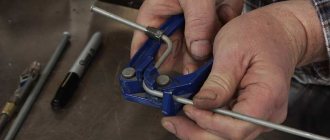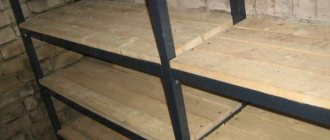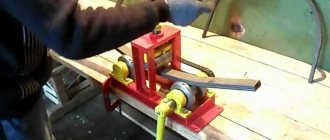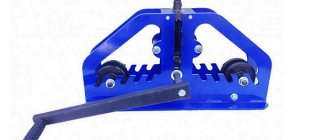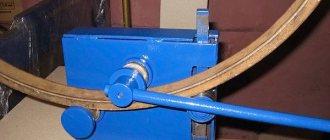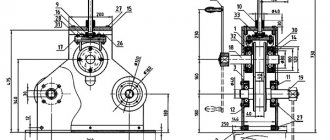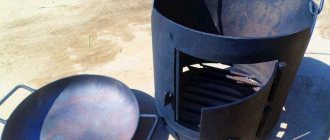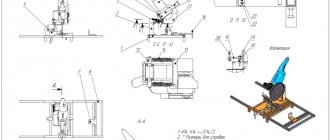Currently, the scope of application of bent parts from round or profile pipes is quite extensive. Most often, such elements are used in the installation of pipelines, decorative finishing, construction of greenhouses, sheds, garages, gazebos and greenhouses.
The principle of operation of the device is very simple, and besides, you can make it yourself, using one of the industrial machines as a sample, or select suitable drawings of the operating equipment on the appropriate portals.
Manual pipe bender - description and characteristics of the device
There are three simple ways in which you can make a simple version of a pipe bender at home. It is enough to have a set of certain plumbing skills, be able to work with electric welding, and also understand technical drawings . If you have a small workshop with plumbing equipment or a metalworking shop at your disposal, then producing a homemade pipe bender will be very simple. If you follow the step-by-step guide, the tool can be built in a few hours.
To make sure that creating a homemade tool is a viable solution, it is enough to pay attention to the cost of factory models. Self-assembly will cost many times less than purchasing it in a store. In addition, such a device can be adjusted to your personal needs by making the necessary changes to the basic configuration, taking into account the specifics of future operation.
Distance from the crimping point to the bend
Brake pipe designs typically have short distances from the start of the pipe to the first bend and from the final bend to the end of the pipe. This is eliminated by manufacturing special sliding shoe inserts, special rollers and clamps, as well as collets of a special design adapted to a specific brake pipe.
Pipe bending machines made in Russia, best suited for bending brake pipes:
- Automatic three-axis pipe bender CE-30 PARTNER.3Х
- Semi-automatic pipe bending machine 3-axis CE-30 PARTNER
- Manual pipe bender for brake pipes 3-axis CM-30/3 PARTNER
- Automatic three-axis pipe bender CE-51 MASTER.3Х
- Semi-automatic pipe bender 3-axis CE-51 MASTER
What are the types
Homemade pipe bending machines are made according to one of four existing types:
- rolling
- winding
- crossbow
- running-in
Each machine has its own design characteristics and scope of application, so when choosing a suitable solution, consider a number of important points. For example, bending copper and thin-walled steel pipes is best done using a roller rolling pipe bender.
It is created in a stationary version with an electric drive or made completely manual. The last option can be used directly on weight.
Particularly mobile are mobile pipe benders, which are indispensable when installing heating or plumbing - such a machine can be taken with you to a construction site, moved outside or to any place. Given its compact size and light weight, it can be easily placed in a plumber’s or welder’s suitcase. Most models weigh no more than 1-2 kilograms.
Advantages of copper pipes
Copper pipes are widely used in almost all areas of our activities.
The advantages arise from the characteristics of the metal:
- use for drinking water supply due to bactericidal properties;
- can withstand physical factors (impacts, bends);
- with low service costs and installations have a long service life;
- low cost, which entails cost savings;
- easy to process and install;
- the presence in the retail chain of a huge selection of equipment for copper products, which makes their installation easy;
- absence of any deposits on the metal walls;
- wide temperature range from -200 to +200 degrees, no deformation when changing temperatures;
- good anti-corrosion properties.
Take note: copper pipes have decorative properties and look good in any interior.
Purpose of the device
A pipe bender for processing profile pipes is quite a popular piece of equipment on the market for the most indispensable tools for a home workshop. Today it is used in a variety of fields, including:
- housing and communal services;
- different areas of industry;
- and many others.
However, before you think about buying or making such a device, you need to understand the principle of its operation and read the step-by-step guide to making it yourself.
Most modern models are capable of solving a number of problems. Among them:
- Changing the direction of pipes at any angle. Sometimes an angle of up to 180 degrees is allowed.
- Processing of pipes with different diameters (its range varies from 5 to 1220 millimeters).
- Deformation of pipes of various types (you can use aluminum, steel, cast iron, and even plastic products).
And if you can change the shape of a plastic pipe with your own efforts, doing the same with a metal structure is quite problematic. In this case, you simply cannot do without the use of professional equipment.
Fortunately, there are several solutions for this situation:
- Purchase professional pipe bending equipment.
- Borrow a suitable tool from a friend or rent it from a special company.
- Try to create a device with your own hands, following the established instructions and tips.
If the task involves infrequent bending of pipes and processing of metal structures, then buying professional devices is impractical and also costly. Instead, it is better to find suitable drawings and video instructions, and then start developing the equipment yourself. With the right approach, you can resolve the issue in a few working hours.
Main rules
The main causes of defects in pipe bending are incorrect (usually too small) bending radius and a short technological shank (“tail”), the distance from the end of the pipe closest to the bend to its beginning. The “tail” is needed not only for reliable fastening of the pipe, the “tail” is also an absorber for the release of technological stresses. A perfectly correct pipe bender can produce a wave or a defect (parasitic bend).
The rules for choosing the bending radius of the pipe RIZG and the length of the technological shank L are summarized in the table:
IZGIZG
- If the difference between the real and the nearest tabulated values of the pipe diameter P is more than 10%, the values of the initial calculated values are calculated by interpolation. Otherwise, we take the nearest one.
- The tabulated RIZG is reduced to the relative value rIZG, i.e. It is expressed in pipe diameters D or heights H.
- For pipes with a diameter of up to 10 mm, 1 is subtracted from rIG.
- For pipes with a diameter of 11 to 15 mm, 0.85 is subtracted from rIG.
- For pipes with a diameter of 16 to 24 mm, 0.75 is subtracted from rIG.
- For pipes with a diameter of 25 to 40 mm, 0.65 is subtracted from rIG.
- For pipes with a diameter of more than 40 mm, 0.5 is subtracted from rIG.
- Convert the relative rIZG back to the numerical (millimeter) RIZG.
- From the obtained value of RIZG, take the nearest practically convenient larger one.
Example: you need to bend 24x24x1.5 from a steel pipe, i.e. already classified as thin-walled, complex semi-arches for a flower house or hut. The structure is non-residential, light, the complex semi-arch is not a load-bearing structure (see below), i.e. "plumbing" wave and taffy are acceptable. We take data for the pipe H=25. According to the table we find rIZG = RIZG/H = 80 mm/25 mm = 3.2. Subtract the correction (for pipe H=25!): 3.2 – 0.65 = 2.55. Convert back to millimeters (again according to the table H=25!): 2.55x25 = 63.75 mm. That is, if we take a new bending radius of 65 mm instead of the “defect-free” 80, then the selection of bending devices and work will be simplified, the possibilities of artistic expression by the shape of the structure will increase, and there will be no visible and/or dangerous defects in the finished structure.
Simple - radius
A specific pipe bender is designed for a bend radius within certain limits. But to select a design prototype, you immediately need to know only its very general meaning:
- for small radii RIZG<5D (or 5H);
- for average radii 5IZG<20 D or H;
- for large radii 20D(H)IG;
Homemade roller pipe bender
Using such a tool, you can accurately bend pipes at an angle of 180 degrees with a small radius. The exact radius is determined by the diameter of the pipe using a special table. To adjust the radius, it is recommended to replace the support roller. Such an operation must be provided for when creating a homemade pipe bender.
An important parameter of the device is the length of the free end from the attachment point to the bending zone. If the pipe is bent at any point along its length, you only need to pay attention to the diameter of the pipe and the bending radius.
If you intend to create a productive device at home, pay attention to the basic drawings and photos of factory models. After carefully studying the relevant information, you can begin to develop a technological scheme and further manufacturing.
In order not to take the entire support roller, you can get by with half of it - a segment. In this case, the tool will become as light as possible and retain its capabilities.
Some useful tips
There are several ways to obtain bent copper pipe. Each is good in its own way, but there are points that are always important to take into account, regardless of the chosen deformation method.
- The main requirement for the user when working is accuracy and attentiveness. Sudden movements will lead to excessive deformation of the pipe walls and their complete rupture.
- Parts made of annealed copper are the easiest to bend, so heating them takes a minimum of time.
- If the bend is not made where needed, you can reheat the workpiece and bend the product back. However, no one guarantees that the shape of the tube will be the same.
- If the surface overheats, the metal may simply begin to melt. It is unacceptable. The user must carefully follow the process from start to finish.
Tool for large radii
If the task is to make an arc for a greenhouse or canopy, the top of a forged fence or a ring, then you can use a roller-type rolling machine with two support rollers and one pressure roller. The operating principle of such a device can be studied with the help of training videos and instructions.
Making a highly efficient machine for profile pipes is much easier than it might seem at first glance. Most drawings and circuit diagrams can be found on the Internet or in specialized literature.
As for the sizes, they can be changed taking into account personal preferences and requirements. Ready-made rollers are sold in specialty stores, but they can be easily turned at home using a lathe and a sheet of durable steel.
If it is necessary to prepare rollers for copper or brass pipes, they are made from durable wood such as oak or beech. Using such equipment you can bend profile and round pipes.
Frame design
Having decided on the center distance and the design of the rollers, you can mark the blank parts for the frame. Based on the experience of FORUMHOUSE users, it should be concluded that the strongest frames are made from steel channels (at least 80 mm wide). This material is easy to get, so you can safely take note of it.
The photo shows the machine at the manufacturing stage. And here is the drawing that is taken as a basis.
Person User FORUMHOUSE
During the work, some changes were made to the original drawings.
The presented drawing is not a mandatory guide to action, but provides an objective understanding of how a rolling pipe bending machine works.
Crossbow type pipe benders
Currently, a widespread method for creating a manual pipe bender is based on an automobile hydraulic jack or using a screw-type mechanical clamping system. If you choose the first option, it will allow you to process steel pipes of any diameter and thickness greater than two millimeters. The second case is suitable for working with steel, copper and other non-ferrous metal pipes with a diameter of no more than 32 millimeters.
As for the jack, it can have different load capacity, but the best range varies between 5-15 tons. The exact indicators depend on the intended type of activity and your financial capabilities. Bottle products with a load capacity of 5 tons or more are quite expensive, so purchasing them for use in domestic conditions, where bending is an infrequent procedure, is simply unreasonable. But if we talk about workshops or workshops, then the power of the jack plays a very important role. It will always be able to solve a complex problem, even if it is necessary to install it under a vehicle.
Crossbow devices have a design limitation in terms of bending angle - they are able to bend the pipe only to an angle of 90 degrees. If it needs to be increased, then a lever or winch is used for this. The main thing is to acquire a support punch or a suitable blank made of metal or durable wood.
If the device is used to process pipes of small thickness, the risk of deformation of the internal walls increases rapidly. Fortunately, such a threat can be localized by filling the pipe with a special filler. It consists of dry fine sand. A similar technology is also used for mandrel pipe benders and the manufacture of coils. Thick-walled products lend themselves to bending much better, however, in this case you need to ensure there is a suitable support in the form of a template or a metal segment. To evaluate the operating principle of a crossbow pipe bender, just look at the external properties of the device.
Complicated bending of copper pipes
It happens that you need to bend a workpiece of a non-standard profile. For example, not round, but square. The spring method is not applicable here. All that remains is to use sand, a mallet, plugs and two supports. A pipe is placed on the latter, then heated, then the bend is tapped with a hammer until it is given the proper shape.
What to do if you need to bend the tube into a spiral? It's simple - you just need to find a cylindrical template with a diameter equal to the required one. The copper workpiece is slightly heated, then bent. This will create an even spiral.
Industrial pipe benders
Most professional hydraulic tools can be equipped with several punches with different radii and groove widths. They are used for industrial purposes, so the main requirement turns to productivity and reliability of the design.
Replacing working punches is easy. In addition, they can be purchased in any size at the appropriate stores and installed on a homemade pipe bender using a vice, jack or other improvised means. It is important not to prioritize low cost, because cheap models cannot be of good quality and perform poorly when processing heavy alloys, especially stainless steel. Such supports can still cope with copper and non-ferrous pipes
Very often, old pulleys cut in half are used as a punch. Such an action is accompanied by many difficulties, but it is quite possible to implement it at home. It is enough to select a suitable pulley with the optimal diameter and groove width. This can be done in specialized markets, online retail outlets and in stores. Sometimes similar products are available in places where scrap metal is accepted . Their cost remains quite affordable.
As for support rollers for industrial devices, sometimes they are created with their own hands, and sometimes they prefer store-bought solutions. If you intend to carry out large volumes of work, it is better to acquire high-quality bearings - in this case, rolling friction will ensure increased productivity and speed of work.
It is necessary to take into account the fact that crossbow products can work in horizontal and vertical positions. However, if it is necessary to move the bending line to a horizontal position, it is better to upgrade standard devices. They are used only for vertical applications and lose their effectiveness at an angle greater than 45 degrees.
The stores offer crossbow jacks for plumbing purposes, which are especially effective for processing non-ferrous pipes and copper products. They can also be used when bending thin-walled steel. Most existing types of crossbow pipe benders are equipped with a manual rather than hydraulic drive. If you need to work with non-ferrous metals, the force provided by the curtain is quite enough to process pipes with a diameter of up to 30 millimeters.
Advantages of using copper pipes
The high popularity of copper pipes, which are actively used in many areas, is explained by a number of advantages that distinguish such products.
- Pathogenic bacteria do not develop on the walls of copper pipes, so these products can be successfully used for installing pipelines through which drinking water is supplied to consumers.
- Copper tolerates mechanical loads of various types quite well.
- Copper piping is extremely durable. At the same time, the costs of its installation and maintenance are relatively low.
- Installation work and preparation for it are quite easy.
- For the installation of pipelines made of copper, a large number of components are available on the modern market, so this procedure does not cause any special problems.
- Plaque does not form on the inner walls of copper pipes. This means that the clearance of the pipeline does not decrease and, accordingly, its operational characteristics do not deteriorate.
- The properties of copper make it possible to successfully operate pipes made from this metal in a fairly wide temperature range: from –200° to +200°.
- Due to the presence of a stable oxide film, copper perfectly resists corrosion, so copper products can be successfully used for a long time.
- Copper pipes are highly decorative, which allows them to be used in almost any interior.
Templates and springs
If pipe bending will not be permanent, but most likely one-time, for example, if it is necessary to build a greenhouse in a country house or a carport, then it is not necessary to build a complex product. A round or profile pipe can be easily bent with minimal effort without the use of special tools.
Existing manual bending methods allow you to change the configuration and direction of pipes with a decent radius and minimal risk of damage to the internal surface. If the task is to bend a thick-walled pipe, then a winch or jack can serve as a traction device. However, if it is necessary to work with pipes with a diameter of up to 40 millimeters, it is enough to apply a little physical effort and muscle strength.
In any case, creating a homemade pipe bender is a completely doable and relatively simple task. Large financial costs are completely absent, if you do not take into account the need to purchase a jack. However, even here the price of a homemade tool is much lower than in the case of purchased solutions.
Bending methods
Methods for giving a curved shape to a copper pipe are divided into two categories:
Industrial flexible tube bending refers to the use of special equipment - pipe benders. The most common are hydraulic and mechanical (manual).
The former make it possible to minimize human physical effort, have replaceable nozzles for selecting a suitable bending diameter, and are used for large copper tubes. The latter are compact, work using human muscle power, and also have replaceable attachments in the form of a semicircle.
When repairing or installing copper pipelines, you don’t always have a pipe bender at hand. Therefore, users make do with improvised means.
Rolling
If we consider pipe benders by degree of evolution, then this type is at the top. This is probably why professionals love to use it so much. Three rotating rollers (sometimes a fourth is added in pair to one of them), gradually changing the pressing force and rolling repeated for each position of the pressing roller - all this ensures the most gentle mode for the pipe. The walls stretch evenly, the profile at each bend section is constant.
The principle of operation is shown in this simple diagram.
There are many examples of implementation. By rolling the pipe in a certain segment and the position of the pressure (middle) roller, the bending radius is adjusted.
The photo below shows the simplest example of a drive (manual), but very attractive in execution.
The frame structure is made of a square pipe; rotating thrust rollers are attached to the side posts on stationary axles. Inside the frame there are paired guides in the form of round pipes along which the pressure roller moves. On the other side of the frame, on the roller axis there is a wheel, due to which the pipe is rolled. The position of the pressure roller is changed using a screw drive.
Using the same scheme, you can make a simpler device.
The principle is the same - execution is easier. The side supports and base are made of sheet metal. The movement of the rod is screw, but additional guides are not needed to move the axis of the pressure roller. Of course, you can’t bend large pipes with it, but it’s suitable for domestic purposes. It has a slight advantage over the first option - the variable position of the support rollers, and therefore a change in the minimum bending radius.
This scheme is also good because the supporting structure can be made of wood. You can leave the roller axes, the handle for rotation and the rod (not to mention the fasteners) as metal. Even the rollers can be made of wood or polymer ones.
These were samples with pipe pulling by rotating the central roller.
You can set the movement with support rollers.
It is easier to design a pipe bender with one roller scrolling, but it has fewer capabilities.
With two rollers rotating simultaneously, the design becomes more complex due to the transmission of rotation between them.
Another example uses the pinch roller tightening from the bottom.
Some believe that this makes it easier to control the work process - the pipe is not “obstructed” by the supporting structure. This model even has two pairs of rollers - for round and profile pipes.
